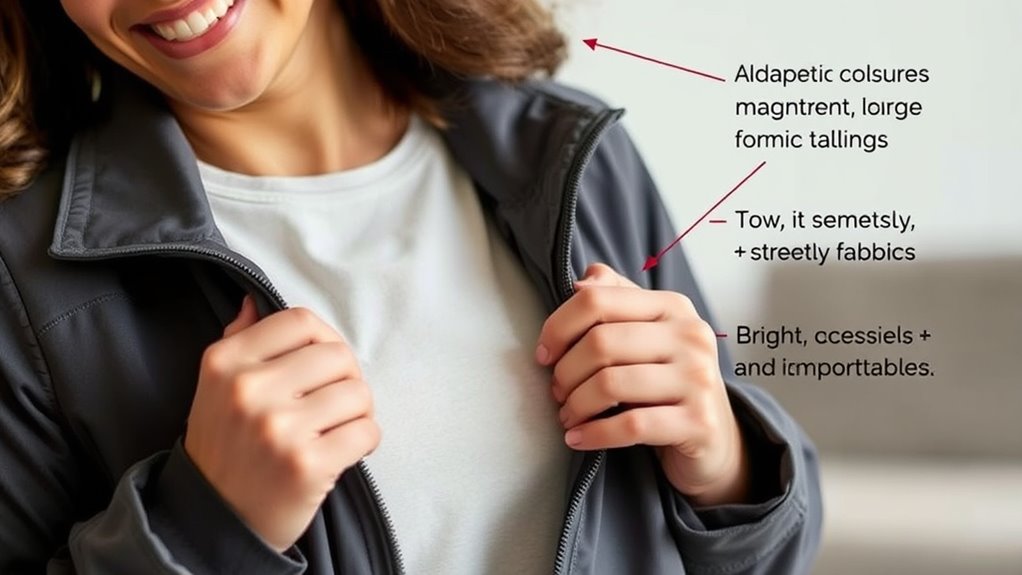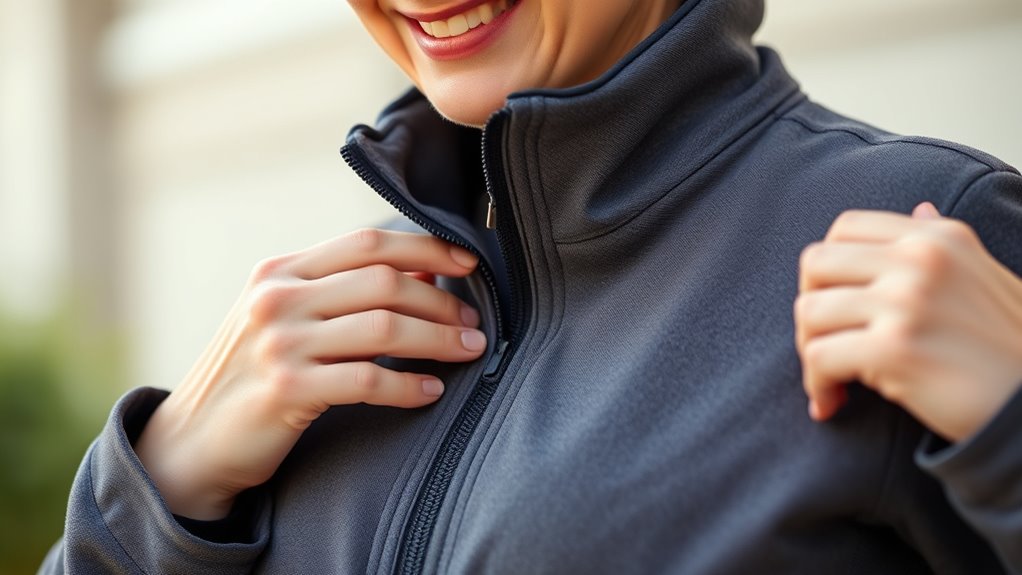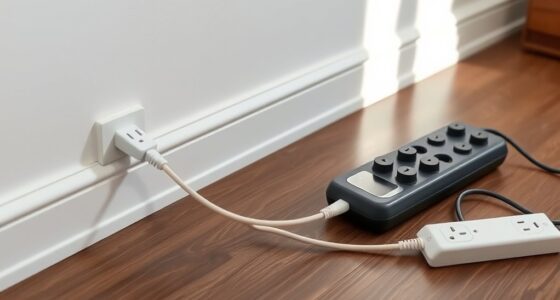Adaptive clothing is designed to make dressing easier, safer, and more comfortable for individuals with mobility issues or disabilities. It features simple closures like magnetic buttons, Velcro, and elastic waistbands, eliminating the need for buttons or zippers. Soft, breathable fabrics also help reduce irritation and increase comfort. These clothes promote independence and help you dress with less frustration. To discover more about how these innovative designs can support your needs, keep exploring this helpful overview.
Key Takeaways
- Adaptive clothing features magnetic closures, Velcro, and elastic waistbands to simplify dressing for individuals with mobility challenges.
- Designed with breathable, soft, and stretchy fabrics to enhance comfort and reduce skin irritation.
- Focuses on ease of dressing through wider openings, adjustable elements, and accessible fastener placements.
- Incorporates user feedback to balance functionality with style, promoting confidence and independence.
- Offers diverse styles and innovations to meet evolving needs, blending fashion and practicality for easier dressing.

Have you ever wondered how clothing can be designed to meet the unique needs of individuals with disabilities or mobility challenges? Adaptive clothing is crafted with this very purpose in mind, making dressing easier, safer, and more comfortable. When exploring adaptive options, you’ll notice that styles and fabrics play a vital role. Designers prioritize simplicity in style, opting for features like magnetic closures, Velcro fasteners, or elastic waistbands instead of traditional buttons and zippers. These modifications help eliminate the struggle of fine motor tasks and make dressing faster and less frustrating. The fabrics chosen also matter greatly; breathable, soft, and stretchy materials are favored because they accommodate sensitive skin, provide comfort, and adapt to different body movements. Think of moisture-wicking fabrics or seamless designs that reduce irritation, especially for those with skin sensitivities or pressure sores. Fabric selection is critical in ensuring comfort and durability in adaptive clothing.
Design considerations for adaptive clothing focus on functionality without sacrificing style. You’ll find that many pieces are designed to be easy to put on and take off, often with wider openings, higher side seams, or adjustable features. For instance, a shirt might have side or back openings with hook-and-loop closures, allowing you or a caregiver to dress with minimal effort. Pants may feature adjustable waistbands or open-back designs that are accessible without complex fasteners. These considerations aren’t just about convenience—they also promote independence, giving you the confidence to dress yourself or your loved ones without assistance. The design process often involves input from people with disabilities, ensuring that clothing truly meets real-world needs.
Incorporating these design considerations and thoughtful fabric choices results in clothing that’s both functional and fashionable. You don’t have to compromise style for practicality anymore; many brands now offer collections that balance aesthetics and accessibility. Whether it’s a sleek hoodie with magnetic closures or a pair of stretchable jeans with elastic waistbands, adaptive clothing aims to blend seamlessly into everyday wardrobes. The focus is on empowering you to dress comfortably and confidently without stress or discomfort. As awareness grows, the range of styles and fabrics continues to expand, offering more options tailored specifically to varied needs. This evolution in design means you’re more likely to find clothing that fits your lifestyle, promotes independence, and aligns with your personal style.
Frequently Asked Questions
How Do I Choose the Right Adaptive Clothing Size?
To select the appropriate adaptive clothing size, start by consulting the size charts provided by the brand, as measurements can vary. Use fitting tips like measuring your body accurately and comparing those numbers to the chart. Consider any special features like adjustable closures or stretchy fabrics that might affect fit. Always try on clothing if possible or buy from places with good return policies to verify comfort and proper fit.
Are Adaptive Clothes Suitable for All Disabilities?
You might think adaptive clothing suits every disability, but that’s a common misconception. For example, someone with limited hand mobility may find certain designs helpful, yet others with sensory sensitivities might not benefit. Adaptive clothing myths often lead to overgeneralizations. While adaptable options exist, they aren’t one-size-fits-all. Carefully assess individual needs to determine if specific styles or features will truly improve ease of dressing for different disabilities.
What Materials Are Best for Sensitive Skin?
For sensitive skin, you should look for adaptive clothing made from hypoallergenic materials like organic cotton, bamboo, or silk. These fabrics offer excellent breathability, reducing irritation and moisture buildup. Avoid synthetic fibers that can cause discomfort or allergic reactions. Choosing soft, natural fabrics helps keep your skin calm and comfortable, making dressing easier and more pleasant throughout the day.
How Can I Style Adaptive Clothing for Formal Occasions?
Think of adaptive clothing as your canvas for elegance. To style it for formal occasions, start with classic pieces like tailored blouses or trousers. Use accessorizing tips such as statement jewelry or sleek shoes to elevate the look. Focus on color coordination by pairing neutral tones with bold accents. This approach creates a polished, sophisticated appearance, letting your adaptive wardrobe seamlessly blend comfort with refined style.
Are There Eco-Friendly Options Available in Adaptive Apparel?
Yes, you can find eco-friendly adaptive apparel made from sustainable fabrics and biodegradable materials. Look for brands committed to environmental responsibility, offering clothing that combines functionality with sustainability. These options help reduce waste and minimize environmental impact while providing comfort and ease of dressing. By choosing adaptive clothing made from eco-conscious materials, you support both your needs and the planet’s health, making your wardrobe more sustainable and environmentally friendly.
Conclusion
Now that you understand adaptive clothing, imagine opening a door to independence and confidence. Just like a key unfastens a new path, these specially designed garments make dressing easier and more comfortable. Embrace the change, and you’ll find that adaptive clothing isn’t just about clothing — it’s about empowering yourself to face each day with dignity and ease. After all, isn’t life about opening doors to new possibilities?









